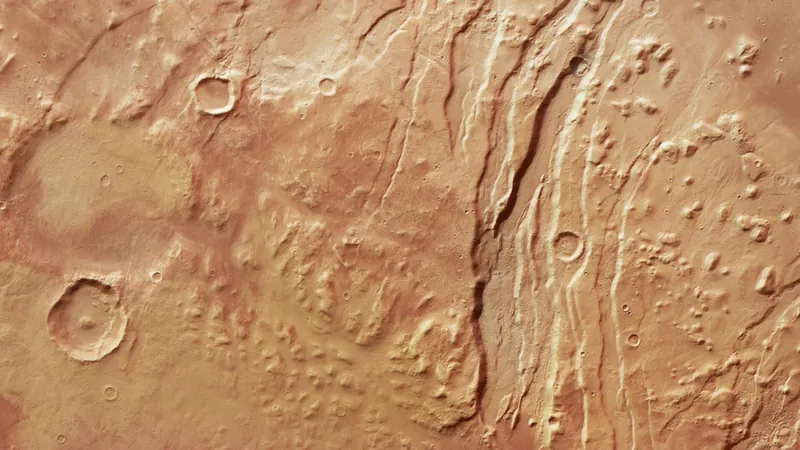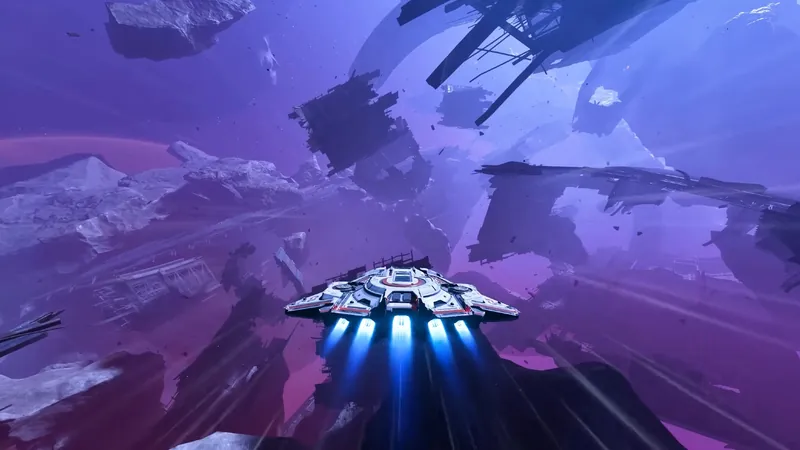
Dive into the Mysteries of Mars: ESA's Stunning New Images Unveil Acheron Fossae!
2025-08-11
Author: Wei Ling
Exploring the Depths of Mars: ESA's Mars Express Unveils Acheron Fossae
For over two decades, the European Space Agency's (ESA) Mars Express orbiter has been sending breathtaking images of the Martian surface back to Earth. Among its most intriguing targets is the Acheron Fossae, a region that continues to captivate scientists and space enthusiasts alike. A recent high-resolution photograph captures the western edge of this mysterious area, providing us with a closer glimpse of its extraordinary topography.
Acheron Fossae: A Landscape of Drama and Intrigue
The Acheron Fossae is a stunning display of geological artistry, featuring fault-like channels that weave across Mars’ surface. These 'fossae' are not just cracks — they are formations of raised ridges known as horsts and sunken valleys called grabens, creating what appears to be long, dramatic scars etched into the planet's crust.
A Glimpse Back in Time: 3.7 Billion Years of Martian History
Scientists believe that this striking landscape emerged around 3.7 billion years ago during Mars' most geologically active phase. Back then, molten rock beneath the planet's surface pushed upwards, stretching the crust and ultimately leading to these vast, miles-long fissures.
Sculpted by Ice: The Role of Rock Glaciers
But the story of Acheron Fossae doesn’t end with ancient geological upheaval. Over the millennia, enormous rock glaciers—composed of rock, sand, and ice—have further shaped this hauntingly beautiful terrain. Just adjacent to the fossae, rounded hills and flat-topped plateaus, known as mesas, have formed as these glaciers moved slowly across the landscape.
A Panoramic View: From Highland to Lowland
The Mars Express image not only showcases the intricacies of Acheron Fossae but also highlights the contrasting landscapes nearby. To the right lies a sprawling lowland plain, while to the left, highlands ascend towards Olympus Mons — the tallest volcano in the solar system — soaring nearly 13.6 miles (22 km) high and located a staggering 746 miles (1,200 km) from Acheron Fossae.
The Cosmic Battle: Impact Craters Tell a Tale
Adding to this awe-inspiring scenery are numerous impact craters scattered throughout the captured image. These craters exist in various states of erosion, hinting at the diverse ages and history of Mars itself. Just like Earth, the Red Planet continues to endure the bombardment of space debris, shaping its surface over eons.
Conclusion: The Ever-Evolving Face of Mars
As the ESA’s Mars Express continues to unveil the secrets of Mars, regions like Acheron Fossae remind us of the dynamic forces that have shaped, and continue to shape, our neighboring world. Each image brings us closer to understanding the planet’s complex geological history — a journey just waiting to unfold!




 Brasil (PT)
Brasil (PT)
 Canada (EN)
Canada (EN)
 Chile (ES)
Chile (ES)
 Česko (CS)
Česko (CS)
 대한민국 (KO)
대한민국 (KO)
 España (ES)
España (ES)
 France (FR)
France (FR)
 Hong Kong (EN)
Hong Kong (EN)
 Italia (IT)
Italia (IT)
 日本 (JA)
日本 (JA)
 Magyarország (HU)
Magyarország (HU)
 Norge (NO)
Norge (NO)
 Polska (PL)
Polska (PL)
 Schweiz (DE)
Schweiz (DE)
 Singapore (EN)
Singapore (EN)
 Sverige (SV)
Sverige (SV)
 Suomi (FI)
Suomi (FI)
 Türkiye (TR)
Türkiye (TR)
 الإمارات العربية المتحدة (AR)
الإمارات العربية المتحدة (AR)